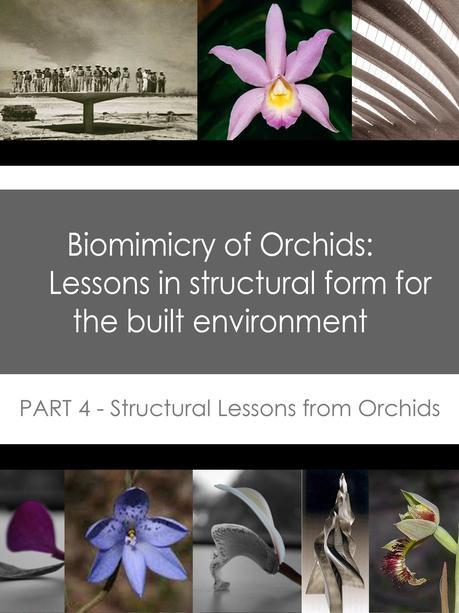
This is part 4 of the Thesis BIOMIMICRY OF ORCHIDS – To read earlier PARTS Click on the Covers BELOW
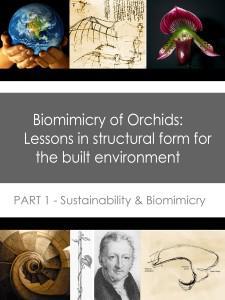

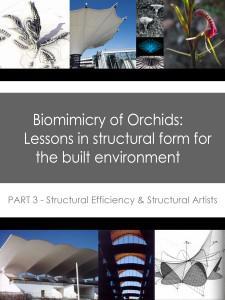
Biomimicry of Orchids: lessons in structural form for the built environment. PART 4 – Structural lessons from Orchids
4. BIOMIMICRY OF ORCHIDS
4.1. Why Orchids?
Orchids come in a multitude of forms despite the imposed limitations of their material properties, indicative of the power of limits. Orchids are often beautiful and through their forms, elegantly span across space, often seemingly defiant to the effects of gravity. Whilst undoubtedly benefiting from their light profiles, in consideration of the scales of magnitude, the relationship between material strength to span is likely to be similar to structures in the built environment. Whilst orchids remain in fluctuation from growth to death, for a period of time they hold their form more or less in a static equilibrium, indicative of structural integrity. Many of the forms and techniques used by structural artists are evident in the forms of orchids as well as a number of unique forms and techniques not common in the built environment. Whilst orchid forms are not restricted by a need for practicality in construction, which is a critical consideration for structural artists, advancements in CAD and CAM technologies provide new possibilities to creating increasingly complex and organic forms. Orchids therefore represent plausible models in structural form.
For the purpose of this thesis it should be noted that the structural integrity of different orchids appear to vary. Whilst all have evidence of structural integrity, some species provide more useful case studies, whilst others due to the inconsistencies in form and high number of deformations raise doubts regarding their structural merit. Furthermore flowers with less consistent orientations appear to adopt more generalised forms to withstand forces from varying directions, which is an uncommon requirement in contemporary structures, although this is likely to gain greater importance in the future. It was found that the most appropriate case studies were orchids with heavier sections, consistent orientations and forms with elements that cantilever in a horizontal plane requiring an intelligent form to withstand increased bending stresses. The Cymbidium orchid was an ideal example of such a species.
4.2. METHODOLOGY
The forms of orchid vary considerably between different species and therefore a range of flowers have been selected for study to provide an adequate sample for the purpose of this thesis.
It was deemed most accurate to analyse the orchids with the assistance of a 3D scanner. The scanner would transform the living orchids into digital 3D models and thus transform something dynamic to something more tangible to be measured. The 3D scanner, as seen in Fig. 20, operates through the use of a laser. The laser collects data as its path is obstructed by the object. As it collects data it converts this into a digitalized model. The laser is fixed, so to achieve scans of 3-Dimensional objects the circular base, by which the object rests, rotates, rises and falls to allow the whole object to be exposed to the axis of the laser beam.

Fig. 20 An example of a 3D scanner Source: (http://www.intellecta.net/3d_scanners.html 15/07/2010)
Whilst the potential for such technology is exciting, it was found that the complexity of the orchid forms, at present precedes the capabilities of the machine in question and the ambitions of the author. A major limitation of the technology is its inability to scan concave surfaces, which are common in the forms of orchids. It is also beyond the capabilities of the fixed laser beam to recognise surfaces that are blocked in both directions by other surfaces in relation to the laser beams axis. In the three-dimensional double-curvature of orchid forms, this was a common occurrence. To attempt to overcome this, the orchids were fixed to a stand and positioned upright to expose the greatest amount of their surface perpendicular to the laser beam. Outcomes were improved, although the stand itself often interfered with the scanning. Furthermore, being held by the stand, the orchids were less secured and movements during the scanning process interfered with the accuracy of data collection. The laser was also lost in darker surfaces where the beam is absorbed and thus no data is registered.
This experience highlights the role in which technology has to play, although it provides caution, as while the potential for such technology is evident, whilst in its infant stages, technologies can remain temperamental. The irratic scans demand a revision of the research scope, whereby greater emphasis will need to come from general observations and analysis from photographs.

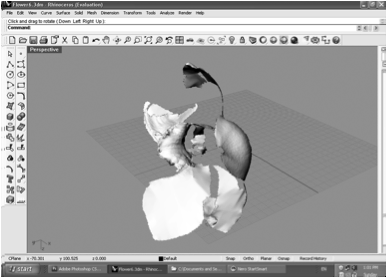
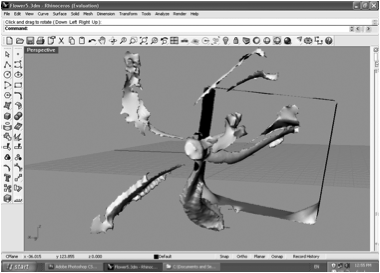
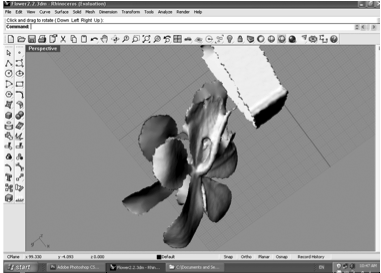

Fig. 21 Irratic 3D scan results
4.3. ANALYSIS AND FINDINGS
Despite the great variety of forms, common structural techniques were found amongst the different orchid species. The first technique which is seen regularly is the use of double curvature, adopting similar forms to that of the hyperbolic paraboloid, with the use of an intersecting arch and cable. This sound structural arrangement forms the basis by which diversity springs, with species adjusting the degrees of curvatures and size of petals. This can be seen in Fig. 22. The Arachnis hookeriana for example, due to its sporadic orientation, adopts a fierce inward curvature, establishing cylindrical like sections. With a section consistent in all directions, cylinders provide an efficient form for beams subject to bending from varied orientations. It is also common for the double curvature of orchids to exhibit a degree of torsion, or triple curvature, to realign the efficient double curvature form against the forces of gravity, thereby maintaining equilibrium.
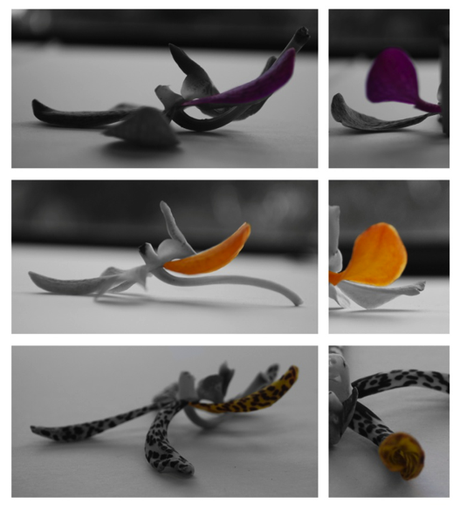
This technique is seen again in the Labellum of many orchids, such as the Cymbidium, as can be seen in Fig. 23. Whilst adopting the double curvature with great effect, the Cymbidium labellum introduces a form not seen in the built environment. The curvature in section has an element of rectilinearity not seen than the conventional hyperbolic paraboloid, as can be observed in the Fig. 24 illustration. The cable is quite pronounced in its verticality providing the labellum with a deep overall section allowing it to resist bending and cantilever outward. The cable in fact, turns inward at its height. This technique provides additional stiffness to the form, acting in a similar manner to perhaps that of an edge beam. The cables more rectilinear form whilst less efficient is in fact quite deliberate and ingenious, as will be explained. Another aspect not seen in the hyperbolic paraboloids of the built environment is the use of internal ribs as seen in Fig 24. These internal beams act as reinforcement to the relatively flat base, which would otherwise be inefficient to the resist bending. When force is applied downward to the lip of the labellum the stiff reinforced base remains structurally stable whilst the weaker surrounds distribute the stresses up the cable walls. The rather square transition from arch to cable is a weakness in the labellum form and this weakness acts as a hinge, whereby the inward curving cable, already naturally inclined by its curvature bends further inward to absorb the stresses. As can be seen in Fig. 25 the labellum form uses hinges both at its articulation and later as the form breaks from its horizontal projection to hang vertically, eliminating bending stresses by balancing the remainder of the mass in equilibrium rather than cantilevering. The hinge at the labellum’s articulation works in unison with the cables inclination to curve inward, for when forces are applied to the lip, the hinge initially provides some flexibility reducing undue stresses on the overall form. The hinge flexed to its relative capacity, forces begin to accumulate and the cable wall is stressed turning further inward. The cables ‘edge beams’ catch on the column, which as seen in Fig. 24 has a form shaped for this very purpose. The column aligned directly from the stem is robust in its materiality and strength and therefore supports the labellum against momentary live loads, which otherwise could destroy the labellum and jeopardise the species reproduction. As can also be seen in the elevation in Fig. 25 the arch curvature is broken by a momentary hump, which is an inverse dome. The dome commences at the completion of the internal beam, where the arch in its totality ends and where the reversed curvature of the dome extends the form further outward. When force is applied to the underside of the inversed dome, the effect is for the orchid form to open outwards. As this force is not one that the dome would naturally experience, its influence to the overall form is indicative of the movement through its manipulation. The inversed dome maintains the forms overall compactness, inward emphasis and overall stability. The use of dome like forms is the second prevalent technique used by orchids.

Fig.23 Terminology of Cymbidium form
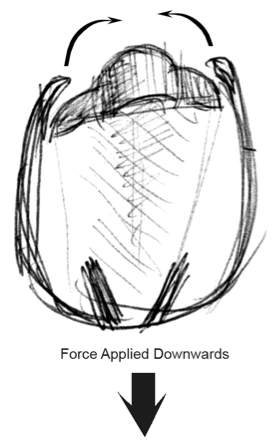
Fig.24 Cross-Section of Labellum
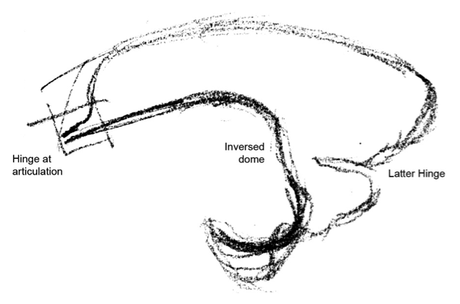
Fig.25 Elevation of Labellum (also seen in Fig. 25)
As was the case with the previous technique, orchid forms quite often adopt dome forms although these vary in curvature and size, again establishing a great diversity in forms as seen in the examples in Fig. 26. More pronounced domes appear to provide more stable forms as seen in the Cymbidium Dorsal Sepal as seen at the top of Fig. 26. In the case of the cymbidium, not only is the dome used to provide a depth in section, but the form also adopts upturning edges which contrast directly to profundity of the dome providing bending resistance along the forms entirety. Upturned edges was a technique also used by Heinz Isler in his Heimberg Tennis Centre as seen in Fig. 28. In Isler’s tennis centre the upturned edges establish double-curvature, which provided his thin shell with the necessary resistance against buckling (Anderson, 2004: p. 102). Likewise the Cymbidiums Dorsal Sepal uses the technique of upturned edges to provide the structure with stiffness. As the form acts as a cantilever, the bending will be greatest near its articulation. As seen in Fig. 27, this is where the upturning of the edges are at their greatest height. The inward turning edges appear to adopt a similar torsion to that of Folded Hypars, whereby it rotates to become horizontal around the dome to resist outward thrusts before returning to its vertical orientation. The ‘edge beams’ appear to play a critical role in the structural stability of the form, acting in tension in the longitudinal direction whilst providing resistance to buckling in the perpendicular plane. Assisting the resistance to bending, near the articulation, is the use of recurrence as seen in Fig.27and the recurrence also features in cross-section becoming thickest at its symmetry of axis, helping to reduce the risks of buckling. The symmetry of axis where the thickness in the longitudinal section is greatest also adopts a relatively straight profile where the forces are directed into the stem. As the form continues to extend outward it begins to exhibits a curvature before turning into the dome form. From general observations the author suggests that the use of dome forms are more prevalent in the more compact orchid forms which have wider petals, whereas the hypars are the preferred forms when greater emphasis is on longitudinal spans. As seen in the elevation in Fig. 27 the overall form from its articulation outward, in consideration to its cross-section, begins as a cable, moving into an arch where at its tip the upward turning edges again produce a cable. The sinuous curves produced from these transitions and likely to gain their stability and form from the upturning edges which acting in tension support the outward projection. The lateral thrusts from the dome form is also likely to be absorbed by the upward edges acting in tension perhaps in a similar manner to steel ties, used in the past around domes.
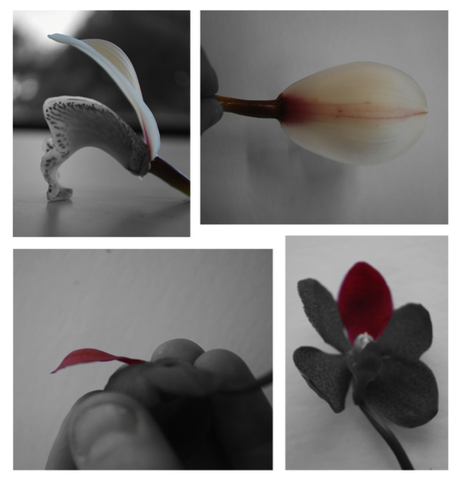
Fig. 26 The use of dome like forms in orchids

Fig. 27 The form of the Cymbidium Dorsal Sepal
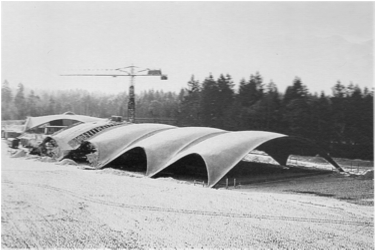
Fig. 28 Heinz Isler’s Heimberg Tennis Center, Switzerland. Source: (Anderson, 2004: p.103)
Another factor of orchid’s forms is of course the flexibility of their materiality. Like the use of hinges the flexible materiality of orchids tends to be used to reduce the accumulation of stresses. This can be beneficial to resist momentary stresses although it can too often result in more permanent deformations.
CONCLUSION
In conclusion, we are at a critical moment in history, whereby sustainability is rapidly becoming a matter of human survival. Biomimicry appears as a highly plausible guideline whereby inspiration from nature could provide humanity with the framework for more intelligent design. The built environment, a major influence on sustainability, must play a critical role and developments in structural efficiency provide enormous scope for significant improvements. Biomimicry has long inspired architects and engineers and with CAD and CAM technologies advancing steadily, the next generation of organic, structurally efficient forms devised from the forces the building is subjected is upon us. Structural artists as well as the diverse orchid forms are terrific examples of the ‘power to tap limits.’ Orchid forms provide many significant lessons in structural efficiency and as building requirements continue to change many of the unique techniques could become increasingly appropriate for the built environment.
SUGGESTED FURTHER RESEARCH
Orchid forms represent a wealth of knowledge for the structural design community. Orchid forms tend to have less precision than those of the built environment, therefore the scope for lessons to be taken, refined and applied are considerable. It would be worthwhile for the study of orchid forms to continue. As orchids are seasonal a longer period of study would be useful. Analysis of the forms structure through complex engineering software would be the logical next step. Lastly, the study of nature’s forms for lesson in structural efficiency should continue to broaden its scope, well beyond that of orchid forms.
ACKNOWLEDGEMENT
REFERENCES
Allen, Edward (2009) Form and forces: designing efficient, expressive structures, John Wiley & Sons, Hoboken, N.J.
Anderson, Stanford (2004) Eladio Dieste : innovation in structural art, Princeton Architectural Press, New York
Angerer, Fred (1961) Surface structures in building, Alec Tiranti, London
Avery, John Scales (2007) Energy, Resources, and the Long-Term Future, World Scientific Series on Energy and Resource Economics – Vol. 4, World Scientific Publishing Co. Pte. Ltd, Hackensack, N.J.
Bar-Cohen, Yoseph (2006) Biomimetics, Taylor & Francis, Boca Raton, F.L.
Benyus, Janine B. (1997) Biomimicry – Innovation inspired by nature, Perrenial, N.Y.
Crippa, Maria Antonietta (2003) Gaudi: From Nature to Architecture, Taschen, Koln, Germany
Descharnes, Robert and Prevost, Clovis (1971) Gaudi: the Visionary, Dorset Press, N.Y.
Enrlich, A. H. (1997) Towards a sustainable global population, in DC Pirages (ed.), Building sustainable societies, pp. 151-65, ME Sharpe, N.Y.
French, M. J. (1988) Invention and evolution: Design in nature and engineering, Cambridge University Press, Cambridge
Garlock, Maria E. Moreyra, Billington, David P. (2009) Felix Candela: engineer, builder, structural artist, Yale university press, London
Iwamoto, Lisa (2002) Embodied Fabrication: computer-aided spacemaking, ACADIA: Education, University of California Berkley, California
Jeanes, Jeffrey, and Backhouse, Gary (2006) Wild Orchids of Victoria, Australia, Tesinska Tiskarna A.S, Czech Republic
Kaplinsky, Joe (2006) Biomimicry versus Humanism, Architectural Design, Volume 76, Issue 1, pp. 66-71, January/February
Kilian, Axel (2004) Fabrication of Partially Double-Curved Surfaces out of Flat Sheet Material Through a 3D Puzzle Approach, Massachusetts Institute of Technology,
Larsen, Olga Popvic and Tyas, Andy (2003) Conceptual structural design : bridging the gap between architects and engineers, Thomas Telford, London
Mainstone, Rowland J. (1998) Developments in Structural Form, Architectural Press, Oxford, 1998
McDonough, William and Braungart, Michael (2002) Cradle to Cradle: Remaking the Way We Make Things, North Point Press, N.Y.
Population Division, Department of Economic and Social Affairs (2007) World Population Prospects
The 2006 Revision: Highlights, United Nations, N.Y.
Schandl, Heinz, Poldy, Franzi, Turner, Graham M., Measham, Thomas G., Walker, Daniel and Eisenmenger, Nina (2008) Australia’s Resource Trajectories, Socio-Economics and the Environment in discussion, CSIRO, Canberra
Sharp, Dennis (1996) Santiago Calatrava, Academy Editions, London
Sullivan, Louis H. (1924) A system of Architectural ornament, Rizzoli, N.Y.
Thompson, D’Arcy Wentworth (1917) On Growth and Form, Cambridge University Press, Cambridge
Tischhauser, Anthony and Moos, Stanislaus von (1998) Calatrava: Public Buildings, Birkhauser Verlag, Berlin
Torroja, Eduardo (1962) Razón y ser de los tipos estructurales/Philosophy of structures, University of California Press, California
Tsui, Eugene (1999) Evolutionary architecture: nature as a basis for design, John Wiley, N.Y.
Tzonis, Alexnder (1999) Santiago Calatrava: The poetics of movement, Thames and Hudson, London
Webster, Mark D. (2004) Relevance of Structural Engineers to Sustainable Design of Buildings, Structural Engineering International, Volume 14, Number 3, 1 August 2004, pp. 181-185 (5), Switzerland
Williams, Christopher (1974) Craftsmen of necessity, Vintage Books, N.Y.
Woodruffs, Lars (2008) design e²: the economies of being environmentally conscious, Force entertainment, N.Y.
